Price reacted downwards off the trend channel on the hourly charts and has bounced up from support at the lower edge.
Summary: Assume resistance and support at the trend channel for the short term. If price breaks above the upper edge, look for a strong bounce. The short term target is at 1,286 – 1,284.
This consolidation may continue for another 12 weeks (including this week). It may be choppy and overlapping, or it may be a sharper pullback. Support may be about 1,315 or possibly as low as 1,284. Resistance should be about 1,365 to 1,375.
A new low below 1,236.54 would indicate Gold remains within a huge bear market. At that stage, new lows would be expected below 1,046.27.
New updates to this analysis are in bold.
Grand SuperCycle analysis is here.
Last in-depth historic analysis with monthly and several weekly charts is here, video is here.
There are multiple wave counts at this time at the weekly and monthly chart levels. In order to make this analysis manageable and accessible only two will be published on a daily basis, one bullish and one bearish. This does not mean the other possibilities may not be correct, only that publication of them all each day is too much to digest. At this stage, they do not diverge from the two possibilities below.
BULLISH ELLIOTT WAVE COUNT
FIRST WEEKLY CHART
Cycle wave b may be a single zigzag. Zigzags subdivide 5-3-5. Primary wave C must subdivide as a five wave structure and may be either an impulse or an ending diagonal. Overlapping at this stage indicates an ending diagonal.
Within an ending diagonal, all sub-waves must subdivide as zigzags. Intermediate wave (4) must overlap into intermediate wave (1) price territory. This diagonal is expanding: intermediate wave (3) is longer than intermediate wave (1) and intermediate wave (4) is longer than intermediate wave (2). Intermediate wave (5) must be longer than intermediate wave (3), so it must end above 1,398.41 where it would reach equality in length with intermediate wave (3).
Within the final zigzag of intermediate wave (5), minor wave B may not move beyond the start of minor wave A below 1,236.54.
Within intermediate wave (1), the correction labelled minor wave B was over within one week. Within intermediate wave (2), the correction labelled minor wave B was too quick to be seen on the weekly chart. Within intermediate wave (3), the correction labelled minor wave B was over in 12 weeks, one short of a Fibonacci 13. Within intermediate wave (4), the correction labelled minor wave B was over in a Fibonacci 8 weeks. As each actionary wave is extending in time as well as price, the correction of minor wave B within intermediate wave (5) may be longer than that within intermediate wave (3). At this early stage, a Fibonacci 13 or possibly even 21 weeks may be expected. This expectation is a rough guideline; flexibility is essential when B waves unfold.
This first weekly chart sees the upwards wave labelled primary wave A as a five wave structure. It must be acknowledged that this upwards wave looks better as a three than it does as a five. The fifth weekly chart below will consider the possibility that it was a three.
FIRST DAILY CHART
Within the ending diagonal, intermediate wave (5) must sub-divide as a zigzag.
Minor wave B may be a reasonably time consuming consolidation or a quicker sharper pullback within the upwards trend, and it may end about either of the 0.382 or 0.618 Fibonacci ratios (neither may be favoured).
There are more than 23 possible structures that minor wave B may take, and it is impossible until close to or at the end to have confidence which possibility has unfolded. When B waves unfold, it is essential that analysis is flexible. B waves are analogous to either range bound consolidations or sharp corrections. As minor wave B unfolds, the labelling on the hourly chart for its sub-waves will change and alternates will be required from time to time.
The yellow arrow outlines the possible pathway for a zigzag for minor wave B. Again, this does not mean this is how price must move within this correction. Minor wave B may still be an expanded flat, triangle or combination. The 0.382 and 0.618 Fibonacci ratios of minor wave A are still targets for minor wave B, and neither are at this time favoured.
Minor wave B may not move beyond the start of minor wave A below 1,236.54.
HOURLY CHART
The strongest piece of analysis on both hourly charts is still the yellow best fit channel. The bottom line is that we should assume price may continue lower while price remains within this channel. If price breaks above the upper edge of this channel tomorrow, then use the alternate hourly chart and look out for a strong bounce within minor wave B.
This main wave count looks at the possibility that minute wave a is a complete impulse. If minute wave a is a five wave structure, then minor wave B may be a zigzag. Minute wave b within the zigzag, if it continues higher, may not move beyond the start of minute wave a above 1,365.68.
The target is calculated at two degrees and is a small zone. This may have a reasonable probability.
If price does unfold as this wave count expects, then when a zigzag downwards may be complete an alternate must be considered where the degree of labelling must be moved down one. A zigzag downwards may be completing for only minute wave a within minor wave B. That would leave the possibilities of a flat, triangle, double zigzag or combination still all open for minor wave B.
ALTERNATE HOURLY CHART
It is also possible that downwards movement to today’s low may be a complete double zigzag, which is classified as a “three”.
Minute wave a may be a complete three wave structure. This may indicate a flat or triangle for minor wave B.
If the wave down to the last low is a double zigzag, then a combination may not be unfolding for minor wave B. The maximum number of corrective structures within a combination is three. To label multiples with multiples increases the maximum beyond three violating the Elliott wave rule. The double zigzag cannot be labelled as minute wave w within a combination for minor wave B.
Within both flats and triangles, minute wave b would be likely to be a strong bounce. The minimum requirement for a flat is 1,361.15. There is no minimum requirement for minute wave b within a triangle.
Within both a flat and triangle, minute wave b may make a new high above the start of minute wave a, as in an expanded flat or running triangle.
A breach of the upper edge of the yellow channel is required for confidence in this wave count for the short term.
BEARISH ELLIOTT WAVE COUNT
FIFTH WEEKLY CHART
There were five weekly charts published in the last historic analysis. This fifth weekly chart is the most immediately bearish wave count, so this is published as a bearish possibility.
This fifth weekly chart sees cycle wave b as a flat correction, and within it intermediate wave (B) may be a complete triple zigzag. This would indicate a regular flat as intermediate wave (B) is less than 1.05 the length of intermediate wave (A).
If cycle wave b is a flat correction, then within it primary wave B must retrace a minimum 0.9 length of primary wave A at 1,079.13 or below. The most common length of B waves within flats is from 1 to 1.38 times the length of the A wave. The target calculated would see primary wave B end within this range.
I have only seen two triple zigzags before during my 10 years of daily Elliott wave analysis. If this wave count turns out to be correct, this would be the third. The rarity of this structure is identified on the chart.
TECHNICAL ANALYSIS
WEEKLY CHART
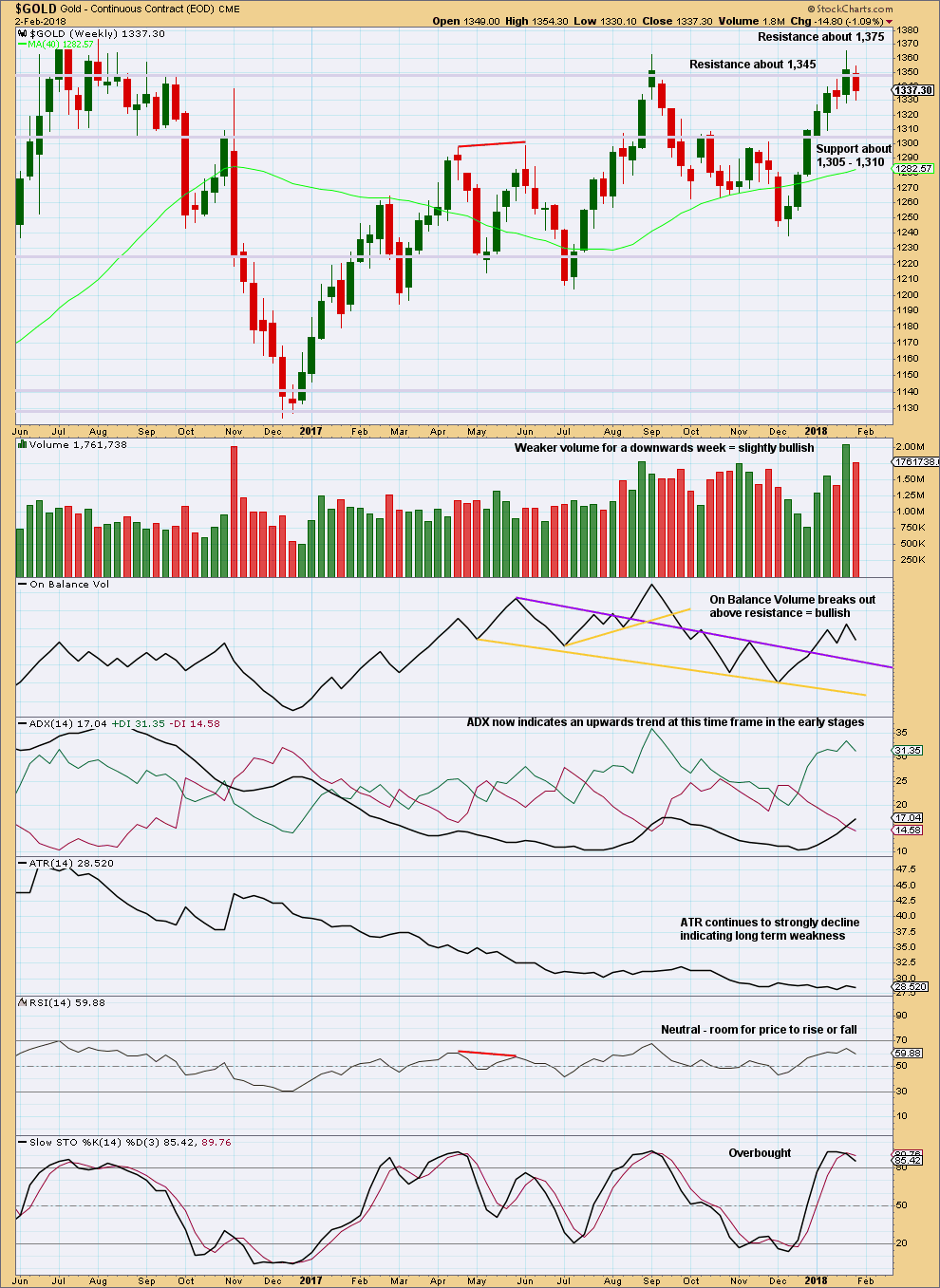
Click chart to enlarge. Chart courtesy of StockCharts.com.
Again, price could not remain above resistance at 1,345 and has closed back below this point. Price remains range bound at this time frame with resistance about 1,378 and support about 1,225. During this consolidation, it is now an upwards week that has strongest volume suggesting an upwards breakout may be more likely than downwards.
Last week’s upwards movement had strong support from volume. This week’s downwards movement does not. The short term volume profile remains bullish.
However, with price at resistance and Stochastics overbought, it would be reasonable to expect an end to the upwards swing here and a downwards swing to support.
DAILY CHART

Click chart to enlarge. Chart courtesy of StockCharts.com.
It looks very much like price is in a smaller consolidation within a possible upwards trend. It may also be a slow start to a downwards swing within the larger consolidation identified on the weekly technical analysis chart.
For the short term, volume during this consolidation suggests an downwards breakout. So far during this consolidation downwards days have stronger volume. The increase in volume today suggests more downwards movement short term as does the long upper wick. This favours the main hourly chart.
GDX DAILY CHART
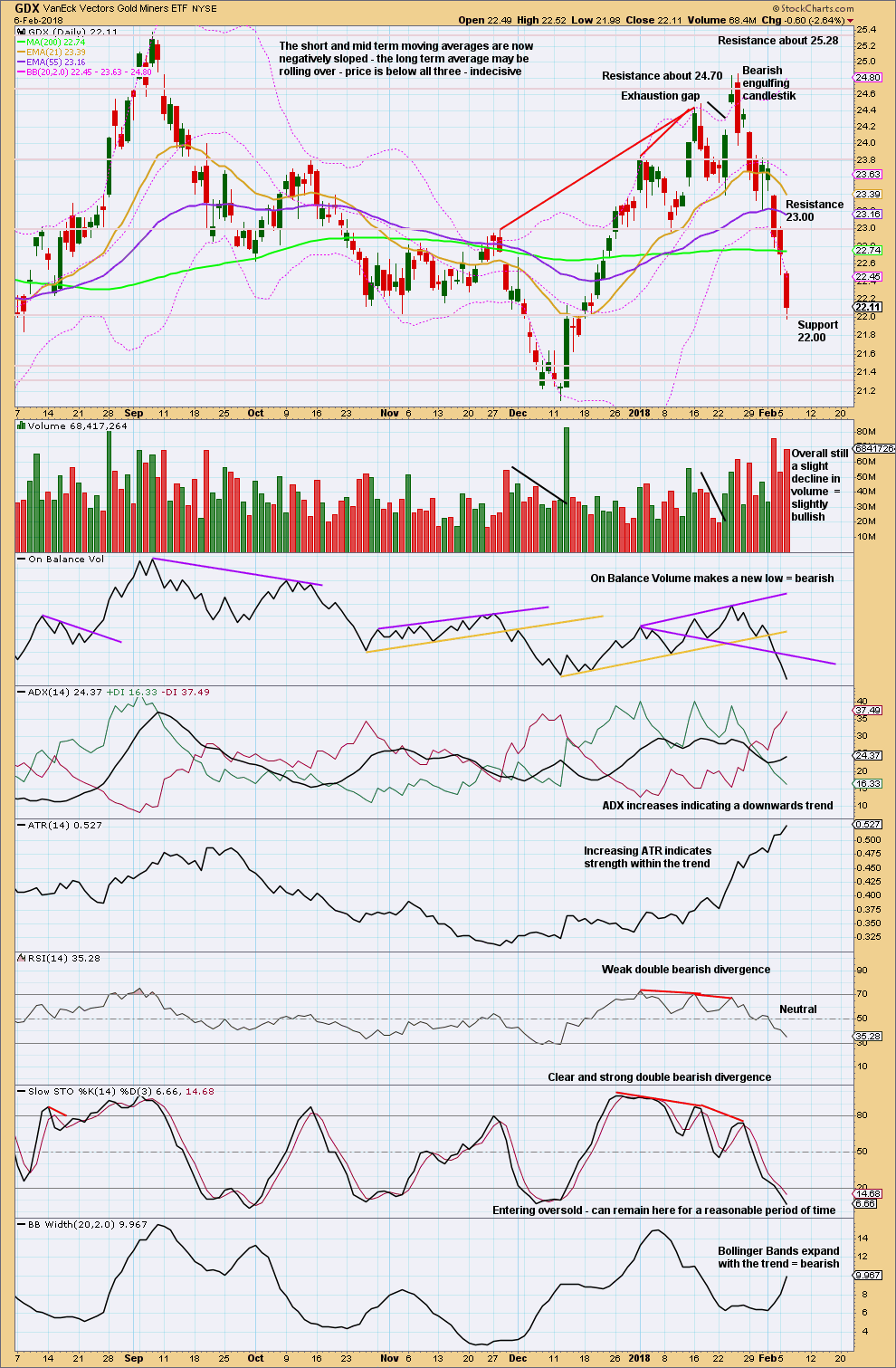
Click chart to enlarge. Chart courtesy of StockCharts.com.
There are now three days in a row with longer lower wicks. This suggests a bounce tomorrow or soon.
Volume and On Balance Volume are contradict each other. Slightly more weight may be given to On Balance Volume, which is bearish at this time.
ADX agrees that there is a downwards trend now. There is room for price to fall further as RSI is not yet oversold and Stochastics exhibits no divergence with price.
Published @ 08:30 p.m. EST.

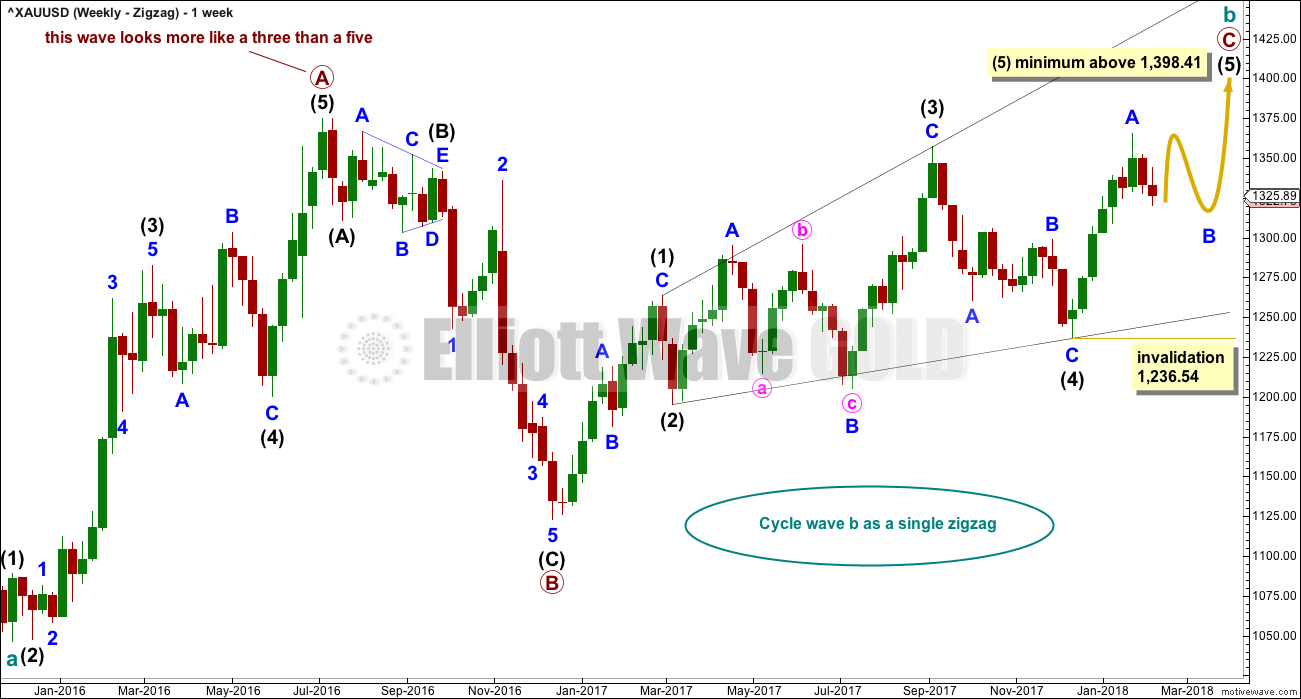
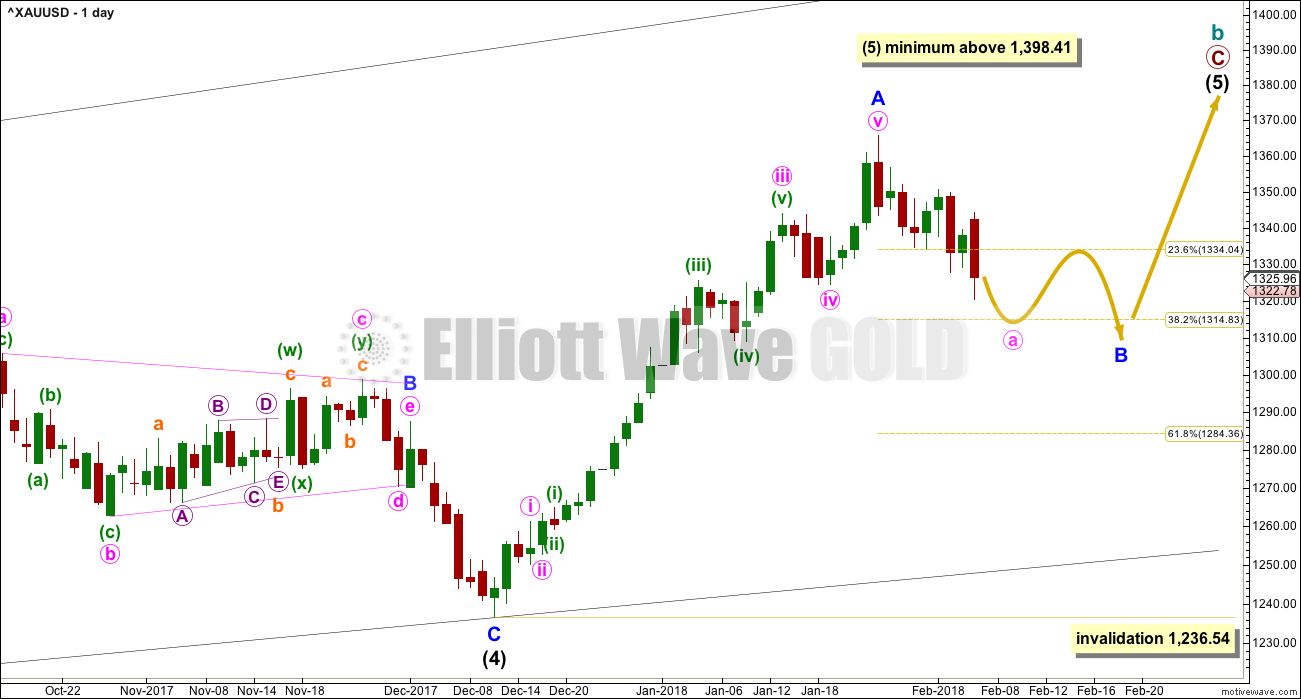
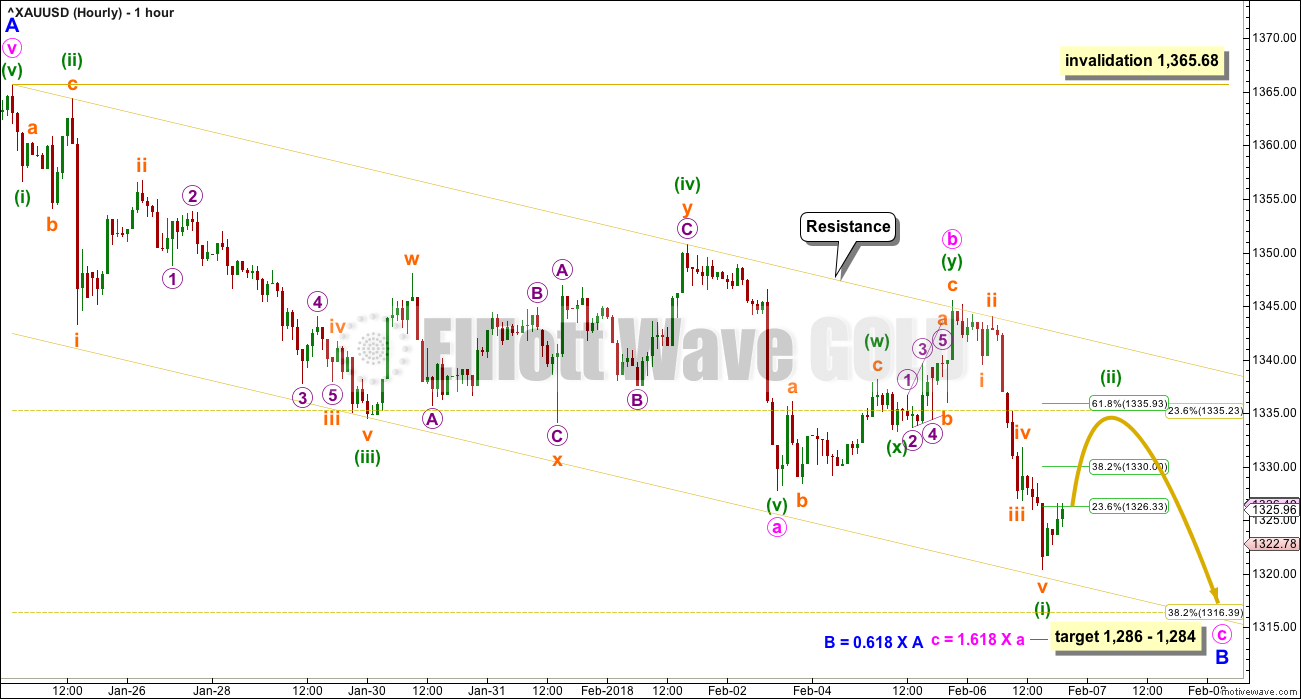

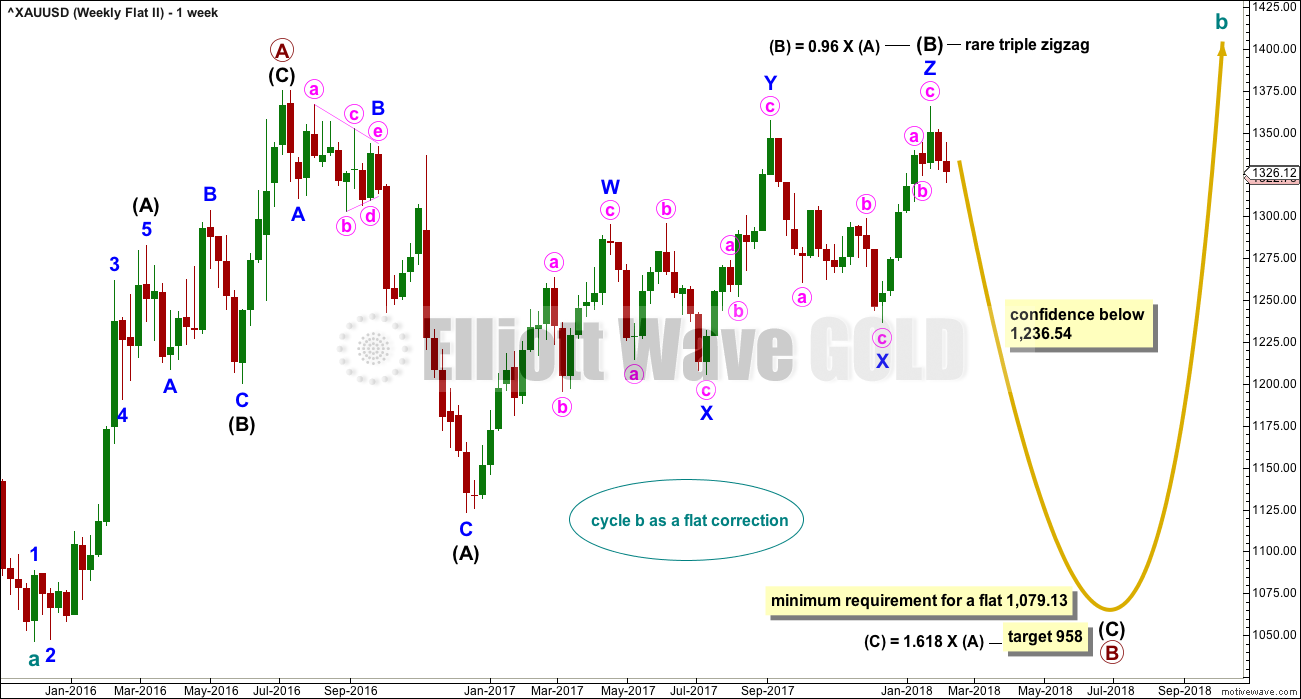
And on downwards towards the target. An increase in momentum looks like a third wave, and so I’ll be considering an alternate where minute a is unfolding lower as a five wave impulse, now in the third wave of that impulse.